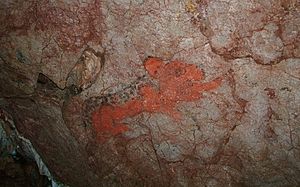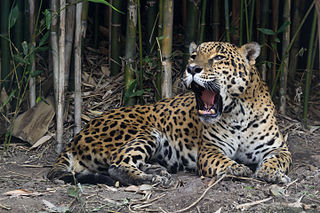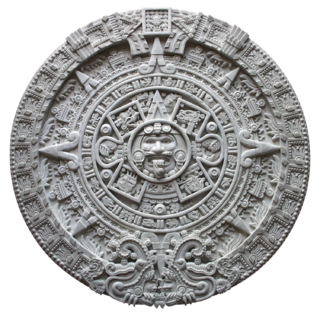
The Olmecs were the earliest known major civilization in Mesoamerica following a progressive development in Soconusco. They lived in the tropical lowlands of south-central Mexico, in the present-day states of Veracruz and Tabasco. It has been speculated that the Olmecs derive in part from neighboring Mokaya or Mixe–Zoque.

This article on the Olmec figurine describes a number of archetypical figurines produced by the Formative Period inhabitants of Mesoamerica. While many of these figurines may or may not have been produced directly by the people of the Olmec heartland, they bear the hallmarks and motifs of Olmec culture. While the extent of Olmec control over the areas beyond their heartland is not yet known, Formative Period figurines with Olmec motifs were widespread in the centuries from 1000 to 500 BCE, showing a consistency of style and subject throughout nearly all of Mesoamerica.

The representation of jaguars in Mesoamerican cultures has a long history, with iconographic examples dating back to at least the mid-Formative period of Mesoamerican chronology. The jaguar is an animal with a prominent association and appearance in the cultures and belief systems of pre-Columbian Mesoamerican societies in the New World, similar to the lion and tiger in the Old World. Quick, agile, and powerful enough to take down the largest prey in the jungle, the jaguar is one of the biggest felids in Central or North America, and one of the most efficient and aggressive predators. Endowed with a spotted coat and well adapted for the jungle, hunting either in the trees or water, making it one of the few felines tolerant of water, the jaguar was, and remains, revered among the indigenous Americans who live closely with the jaguar.

The religion of the Olmec people significantly influenced the social development and mythological world view of Mesoamerica. Scholars have seen echoes of Olmec supernatural in the subsequent religions and mythologies of nearly all later pre-Columbian era Mesoamericans cultures.

Teopantecuanitlan is an archaeological site in the Mexican state of Guerrero that represents an unexpectedly early development of complex society for the region. The site dates to the Early to Middle Formative Periods, and archaeological evidence clearly indicates some kind of connection existed between Teopantecuanitlan and the Olmec heartland of the Gulf Coast. Prior to the discovery of Teopantecuanitlan in the early 1980s, little was known about the region's sociocultural development and organization during the Formative period.

Chalcatzingo is a Mesoamerican archaeological site in the Valley of Morelos dating from the Formative Period of Mesoamerican chronology. The site is well known for its extensive array of Olmec-style monumental art and iconography. Located in the southern portion of the Central Highlands of Mexico, Chalcatzingo is estimated to have been settled as early as 1500 BCE. The inhabitants began to produce and display Olmec-style art and architecture around 900 BCE. At its height between 700 BCE and 500 BCE, Chalcatzingo's population is estimated at between five hundred and a thousand people. By 500 BCE it had gone into decline.
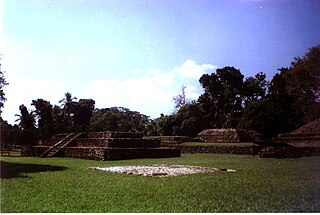
Izapa is a very large pre-Columbian archaeological site located in the Mexican state of Chiapas; it is best known for its occupation during the Late Formative period. The site is situated on the Izapa River, a tributary of the Suchiate River, near the base of the volcano Tacaná, the sixth tallest mountain in Mexico.

Bloodletting was the ritualized self-cutting or piercing of an individual's body that served a number of ideological and cultural functions within ancient Mesoamerican societies, in particular the Maya. When performed by ruling elites, the act of bloodletting was crucial to the maintenance of sociocultural and political structure. Bound within the Mesoamerican belief systems, bloodletting was used as a tool to legitimize the ruling lineage's socio-political position and, when enacted, was important to the perceived well-being of a given society or settlement.
Mesoamerica, along with Mesopotamia and China, is among the three known places in the world where writing has thought to have developed independently. Mesoamerican scripts deciphered to date are a combination of logographic and syllabic values. They are often called hieroglyphs due to the iconic shapes of many of the glyphs, a pattern superficially similar to Egyptian hieroglyphs. Fifteen examples of distinct writing systems have been identified in pre-Columbian Mesoamerica, many from a single inscription. The limits of archaeological dating methods make it difficult to establish which was the earliest and hence the fore-bearer from which the others developed. The best documented and deciphered Mesoamerican writing system, and the most widely known, is the classic Maya script. An extensive Mesoamerican literature has been conserved partly in indigenous scripts and partly in the postconquest transcriptions in the Latin script.

Ancient Maya art refers to the material arts of the Maya civilization, an eastern and south-eastern Mesoamerican culture that took shape in the course of the later Preclassic Period. Its greatest artistic flowering occurred during the seven centuries of the Classic Period. Ancient Maya art then went through an extended Post-Classic phase before the upheavals of the sixteenth century destroyed courtly culture and put an end to the Mayan artistic tradition. Many regional styles existed, not always coinciding with the changing boundaries of Maya polities. Olmecs, Teotihuacan and Toltecs have all influenced Maya art. Traditional art forms have mainly survived in weaving and the design of peasant houses.
The causes and degree of Olmec influences on Mesoamerican cultures has been a subject of debate over many decades. Although the Olmecs are considered to be perhaps the earliest Mesoamerican civilization, there are questions concerning how and how much the Olmecs influenced cultures outside the Olmec heartland. This debate is succinctly, if simplistically, framed by the title of a 2005 New York Times article: “Mother Culture, or Only a Sister?”.

Oxtotitlán is a natural rock shelter and archaeological site in Chilapa de Álvarez, Mexican state of Guerrero that contains murals linked to the Olmec motifs and iconography. Along with the nearby Juxtlahuaca cave, the Oxtotitlán rock paintings represent the "earliest sophisticated painted art known in Mesoamerica", thus far. Unlike Juxtlahuaca, however, the Oxtotitlán paintings are not deep in a cave system but rather occupy two shallow grottos on a cliff face.

Las Limas Monument 1, also known as the Las Limas figure or the Señor de las Limas, is a 55 centimetres (22 in) greenstone figure of a youth holding a limp were-jaguar baby. Found in the State of Veracruz, Mexico, in the Olmec heartland, the statue is famous for its incised representations of Olmec supernaturals. It is the largest known greenstone sculpture.
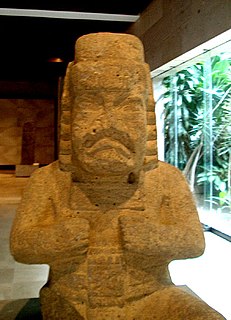
The were-jaguar was both an Olmec motif and a supernatural entity, perhaps a deity.

The Feathered Serpent was a prominent supernatural entity or deity, found in many Mesoamerican religions. It was called Quetzalcoatl among the Aztecs, Kukulkan among the Yucatec Maya, and Q'uq'umatz and Tohil among the K'iche' Maya. The double symbolism used in its name is considered allegoric to the dual nature of the deity, where being feathered represents its divine nature or ability to fly to reach the skies and being a serpent represents its human nature or ability to creep on the ground among other animals of the Earth, a dualism very common in Mesoamerican deities.
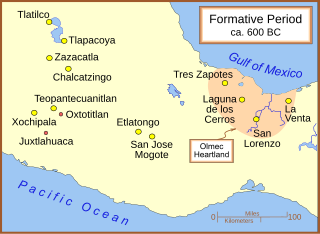
Xochipala is a minor archaeological site in the Mexican state of Guerrero, whose name has become attached, somewhat erroneously, to a style of Formative Period figurines and pottery from 1500 to 200 BCE. The archaeological site belongs to the Classic and Postclassic eras, from 200-1400 CE.
Cacahuaziziqui is a pre-Columbian cave site containing Olmec paintings. It is located in the Mexican province of Guerrero on the southern coast of the country. The site is located 30 miles west of Oxtotitlan and Juxtlahuaca and southeast of Tlapa, a mountainous area in the Guerrero state. The Guerrero caves are often located in remote canyons.

Regional communications in ancient Mesoamerica are believed to have been extensive. There were various trade routes attested since prehistoric times. In this article, especially the routes starting in the Mexico Central Plateau, and going down to the Pacific coast will be considered. These contacts then went on as far as Central America.






